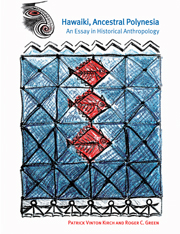Book contents
- Frontmatter
- Contents
- List of figures
- List of tables
- Preface
- List of language abbreviations
- Prologue: on historical anthropology
- Part I The phylogenetic model: theory and method
- 1 The phylogenetic model in historical anthropology
- 2 Methodologies: implementing the phylogenetic model
- 3 Polynesia as a phylogenetic unit
- Part II Rediscovering Hawaiki
- Epilogue: on history, phylogeny, and evolution
- Notes
- Glossary of terms
- References
- Subject Index
- Index of Proto Polynesian Reconstructions
2 - Methodologies: implementing the phylogenetic model
Published online by Cambridge University Press: 06 January 2010
- Frontmatter
- Contents
- List of figures
- List of tables
- Preface
- List of language abbreviations
- Prologue: on historical anthropology
- Part I The phylogenetic model: theory and method
- 1 The phylogenetic model in historical anthropology
- 2 Methodologies: implementing the phylogenetic model
- 3 Polynesia as a phylogenetic unit
- Part II Rediscovering Hawaiki
- Epilogue: on history, phylogeny, and evolution
- Notes
- Glossary of terms
- References
- Subject Index
- Index of Proto Polynesian Reconstructions
Summary
Anthropologists have long recognized that cultural traditions in different societies can be related phylogenetically in that they derive historically from a common ancestral tradition in the same way that languages can be related phylogenetically. Problems of method for convincingly establishing such relations for cultural traditions have remained unresolved. Remote Oceania, where we have reason to assume that nearly all existing cultural traditions are phylogenetically related, offers possibilities for comparative study to illustrate the methodological issues to be resolved.
goodenough 1997:16Sophisticated application of a phylogenetic model in historical anthropology requires a rigorous methodology. Using our Polynesian case, we begin with the problem of correlating linguistic and archaeological evidence, followed by possible models for linguistic divergence. We will show that such models are not limited to strictly “tree-like” branching models; historical linguists have recently developed “network-breaking,” or “dialect-chain” models that are more appropriate to Pacific history. This in turn leads to matters of defining “homelands,” and of establishing time depth. All of these issues are essential to establishing a proper phylogenetic framework. The second half of this chapter examines what we call the “triangulation method” in historical anthropology, which allows one to achieve a reconstruction of the ancestral culture which lies at the root of a phylogenetic “tree.” The procedural details of the triangulation method will take us into the realm of lexical and semantic reconstruction, especially the “recovery of meaning” by using comparative ethnographic materials to develop specific semantic history hypotheses.
Information
- Type
- Chapter
- Information
- Hawaiki, Ancestral PolynesiaAn Essay in Historical Anthropology, pp. 32 - 52Publisher: Cambridge University PressPrint publication year: 2001
